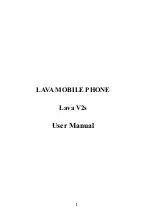
Section 4: Safety Guidelines and Warranty Information
201
4A: Safety
the licensee is not required to provide the FCC with specific location and
operating parameters of these facilities.
Information on site specific licensed facilities can be found the “General
Menu Reports” (GenMen) at
http://gullfoss2.fcc.gov/cgi-bin/ws.exe/genmen/index.hts
.
The various FCC Bureaus also publish on at least a weekly basis, bulk
extracts of their licensing databases. Each licensing database has its own
unique file structure. These extracts consist of multiple, very large files.
The FCC’s Office of Engineering and Technology (OET) maintains an
index to these databases at
http://www.fcc.gov/oet/info/database/fadb.html
. Entry points into the
various databases include frequency, state/county, latitude/longitude,
call-sign and licensee name. For further information on the
Commission’s existing databases, you can contact Donald Campbell at
or 202-418-2405.
15. Can local and state governmental bodies establish limits for RF
exposure?
Although some local and state governments have enacted rules and
regulations about human exposure to RF energy in the past, the
Telecommunications Act of 1996 requires the Federal Government to
control human exposure to RF emissions. In particular, Section 704 of
the Act states that, “No State or local government or instrumentality
thereof may regulate the placement, construction, and modification of
personal wireless service facilities on the basis of the environmental
effects of radio frequency emissions to the extent that such facilities
comply with the Commission’s regulations concerning such emissions.”
Further information on federal authority and FCC policy is available in a
fact sheet from the FCC’s Wireless Telecommunications Bureau at
www.fcc.gov/wtb
.
16. Do wireless phones pose a health hazard?
The available scientific evidence does not show that any health problems
are associated with using wireless phones. There is no proof, however,
that wireless phones are absolutely safe. Wireless phones emit low levels
of radiofrequency energy (RF) in the microwave range while being used.
They also emit very low levels of RF when in the stand-by mode. Whereas
Summary of Contents for SH-P300
Page 1: ...Online User s Guide Single Band PCS Phone Model SH P300 ...
Page 9: ......
Page 11: ...2 ...
Page 13: ...4 ...
Page 14: ...Section 1 5 Getting Started Section 1 Getting Started ...
Page 15: ...6 ...
Page 20: ...Section 2 11 Understanding Your Phone Section 2 Understanding Your Phone ...
Page 21: ...12 ...
Page 81: ...Section 2 Understanding Your Phone 72 2F Managing Call History ...
Page 123: ...Section 2 Understanding Your Phone 114 2H Personal Organizer ...
Page 149: ...Section 2 Understanding Your Phone 140 2J E mail ...
Page 150: ...Section 3 141 Using PCS Service Features Section 3 Using PCS Service Features ...
Page 151: ...142 ...
Page 185: ...Section 3 Using PCS Service Features 176 3B PCS Vision ...
Page 189: ...Section 3 Using PCS Service Features 180 3C PCS Voice Command ...
Page 191: ...182 ...
Page 224: ...215 ...
Page 235: ......
Page 237: ...2 ...
Page 239: ...4 ...
Page 240: ...Sección 1 5 Cómo empezar Sección 1 Cómo empezar ...
Page 241: ...6 ...
Page 246: ...Sección 2 11 Familiarícese con su teléfono Sección 2 Familiarícese con su teléfono ...
Page 247: ...12 ...
Page 307: ...Sección 2 Familiarícese con su teléfono 72 2F Registros de llamadas ...
Page 349: ...Sección 2 Familiarícese con su teléfono 114 2H Organizador personal ...
Page 375: ...Sección 2 Familiarícese con su teléfono 140 2J E mail ...
Page 377: ...142 ...
Page 411: ...Sección 3 Cómo usar las funciones del servicio PCS 176 3B PCS Vision ...
Page 415: ...Sección 3 Cómo usar las funciones del servicio PCS 180 3C PCS Voice Command ...
Page 417: ...182 ...
Page 452: ...Sección 4 Pautas de seguridad e información de garantía 217 4B Garantía limitada al cliente ...
















































